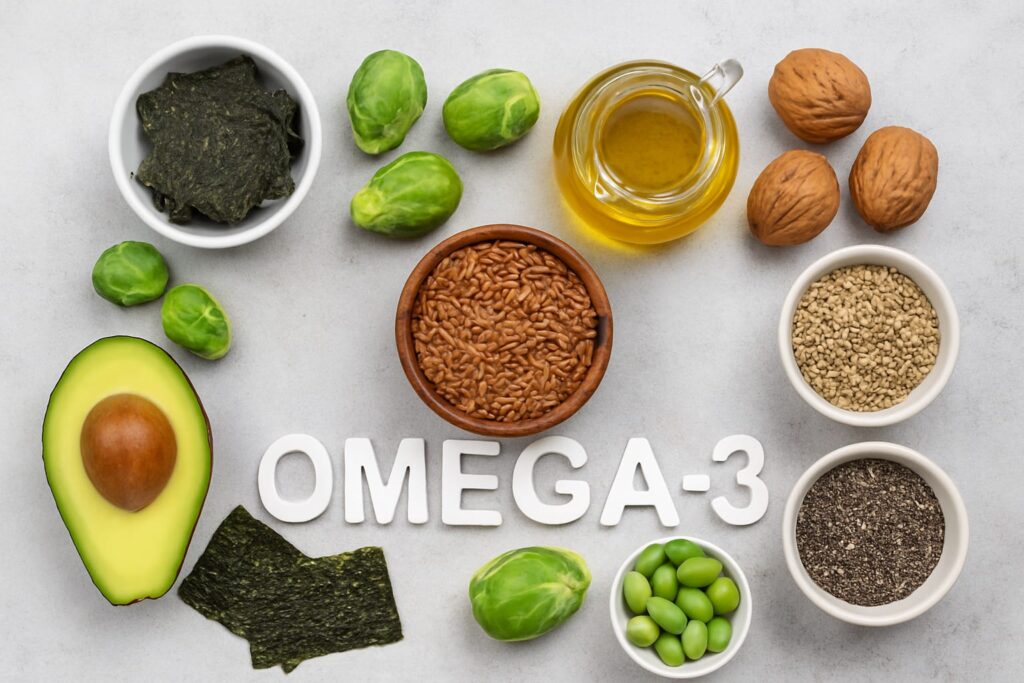Plant-Based Omega-3 Sources: Top 10 Picks
If you’re looking for plant-based omega-3 sources to support your brain, heart, and overall health, you’re not alone. More and more people are turning to vegan and vegetarian lifestyles, yet they still need to meet essential fatty acid requirements. Omega-3s are well-known for their anti-inflammatory effects and cognitive benefits, but they’re often associated with fish oil. Fortunately, there are several powerful plant-based omega-3 sources that offer a sustainable, cruelty-free alternative, and many of them might already be in your kitchen.

What Are Omega-3 Fatty Acids?
Omega-3 fatty acids are a type of polyunsaturated fat that plays a crucial role in various bodily functions. They’re classified into three main types:
- ALA (Alpha-linolenic acid) – Found mostly in plants
- EPA (Eicosapentaenoic acid) – Commonly found in fatty fish
- DHA (Docosahexaenoic acid) – Also found in marine sources
Plant foods primarily provide ALA, which the body can convert into EPA and DHA, though the conversion rate is relatively low. Still, a diet rich in plant-based omega-3 sources can significantly contribute to your daily needs, especially when paired with the right nutrients.
Why Choose Plant-Based Omega-3 Sources?
Choosing plant-based omega-3 sources is not only environmentally friendly but also suitable for people with dietary restrictions. In addition, plant foods often come with added health benefits, such as fiber, antioxidants, and phytonutrients, which support long-term wellness.
Besides, many fish oils on the market are contaminated with heavy metals or over-processed, which leads many health-conscious individuals to search for safer, cleaner alternatives.
How Much Omega-3 Do You Need?
The National Institutes of Health (NIH) recommends the following daily intake of ALA:
- Men: 1.6 grams
- Women: 1.1 grams
Though this amount seems small, it’s crucial to be consistent. Including a variety of plant-based omega-3 sources throughout your week is one of the most effective ways to reach your targets naturally.
Top 10 Plant-Based Omega-3 Sources
Here’s a list of the most powerful plant-based omega-3 sources, including their benefits and suggested daily intakes.
1. Flaxseeds: Tiny But Mighty
Flaxseeds are one of the richest plant-based omega-3 sources, containing around 6.5g of ALA per tablespoon of ground seeds. Because whole flaxseeds pass through the digestive system undigested, it’s best to use ground flaxseed or cold-pressed flaxseed oil.
How to Use: Add ground flaxseed to smoothies, oatmeal, or baked goods.
Bonus Tip: Store them in the fridge to preserve freshness.
2. Chia Seeds: The Superfood Hero
Just one ounce of chia seeds offers over 5 grams of ALA, making them one of the top plant-based omega-3 sources available. In addition to omega-3s, chia seeds are loaded with fiber, magnesium, and calcium.
How to Use: Mix with water for chia pudding or sprinkle on salads.
Why It Works: Their gelatinous texture promotes digestion and hydration.
3. Hemp Seeds: Balanced Nutrition
Hemp seeds provide a perfect omega-3 to omega-6 ratio, delivering about 3 grams of ALA per tablespoon. They’re also packed with protein and essential amino acids.
How to Use: Blend into protein shakes or sprinkle on avocado toast.
Added Benefit: Hemp is one of the easiest plants to digest.
4. Walnuts: Crunchy Brain Boosters
Walnuts contain roughly 2.5 grams of ALA per ounce. Not only are they excellent plant-based omega-3 sources, but they’re also linked to improved cognitive performance.
How to Use: Enjoy as a snack or chopped into salads and grain bowls.
Nutrition Note: Choose raw or dry-roasted to avoid added oils.
5. Algal Oil: The Marine-Free Fish Oil
Algal oil is derived from algae, the original source of EPA and DHA for fish. It’s one of the rare plant-based omega-3 sources that offers EPA and DHA directly, making it perfect for vegans.
How to Use: Take in capsule form or use in smoothies.
Clinical Advantage: Studies show algal oil is just as effective as fish oil in raising DHA levels.
6. Brussels Sprouts: Green Power
Surprisingly, cooked Brussels sprouts contain small but significant amounts of ALA. While not as dense as seeds or oils, they still contribute to your intake, especially when consumed regularly.
How to Use: Roast with olive oil or sauté with garlic and lemon.
Pro Tip: Pair with vitamin C–rich foods to enhance absorption.
7. Seaweed and Nori: Ocean’s Green Gold
Various sea vegetables like seaweed and nori contain traces of EPA and DHA. These are among the few plant-based omega-3 sources that offer marine-type omegas without the fish.
How to Use: Add to miso soup, salads, or sushi rolls.
Sustainability Factor: Seaweed cultivation is eco-friendly and regenerative.
8. Edamame and Soybeans: Plant Protein and Omegas
Whole soybeans and products like edamame, tofu, and tempeh provide modest amounts of ALA. They’re ideal for people who want a protein-rich option with added omega-3 benefits.
How to Use: Steam, stir-fry, or add to bowls and wraps.
Extra Benefit: High in isoflavones that support hormonal balance.
9. Canola Oil: Everyday Cooking Oil
Canola oil contains approximately 1.3 grams of ALA per tablespoon. It’s a simple way to increase your plant-based omega-3 sources through cooking and dressings.
How to Use: Replace vegetable oils in sautéing or baking.
Caution: Choose cold-pressed, organic varieties when possible.
10. Perilla Oil: Popular in Asian Cuisine
Derived from perilla seeds, this lesser-known oil is packed with omega-3s, offering around 9g of ALA per tablespoon. It’s widely used in Korean cooking and herbal remedies.
How to Use: Drizzle on rice dishes or use in marinades.
Flavor Profile: Mild and nutty, ideal for raw applications.
Boosting Omega-3 Absorption from Plant Foods
Even though ALA conversion to EPA/DHA is limited, several strategies can improve your body’s ability to use these plant-based omega-3 sources efficiently:
- Limit omega-6 intake (from vegetable oils and processed foods)
- Get enough zinc and magnesium to support enzymatic conversion
- Eat foods rich in vitamin B6 and C for better metabolism of ALA
- Combine sources daily for consistent intake
Do You Need Omega-3 Supplements?
While it’s entirely possible to meet your needs through plant-based omega-3 sources, some people choose to take a vegan omega-3 supplement, especially algal oil, to ensure they’re getting enough EPA and DHA. This is particularly recommended for pregnant individuals or those with inflammatory conditions.
FAQs About Plant-Based Omega-3 Sources
Is flaxseed better than chia seed for omega-3?
Both options are highly nutritious, though flaxseeds contain a bit more ALA per serving. On the other hand, chia seeds provide extra hydration and support for digestive health thanks to their gel-forming fiber.
Can I get enough omega-3s on a vegan diet?
Yes, with proper planning and variety, vegans can meet their omega-3 needs using plant-based sources and possibly supplements.
Are walnuts a complete source of omega-3?
Walnuts contain ALA, not EPA or DHA. Still, they are incredibly beneficial and contribute to your daily intake.
Final Thoughts
There’s no need to rely on fish oil to get enough omega-3s. A wide variety of accessible, nutrient-rich plant foods can help you maintain optimal health while also supporting sustainability and ethical living.
By including a mix of seeds, nuts, legumes, and algae-derived products in your daily meals, you can effectively meet your ALA needs and enjoy a broad spectrum of beneficial nutrients found in whole plant foods. The secret lies in consistency, along with a bit of creativity in how you prepare your meals.
